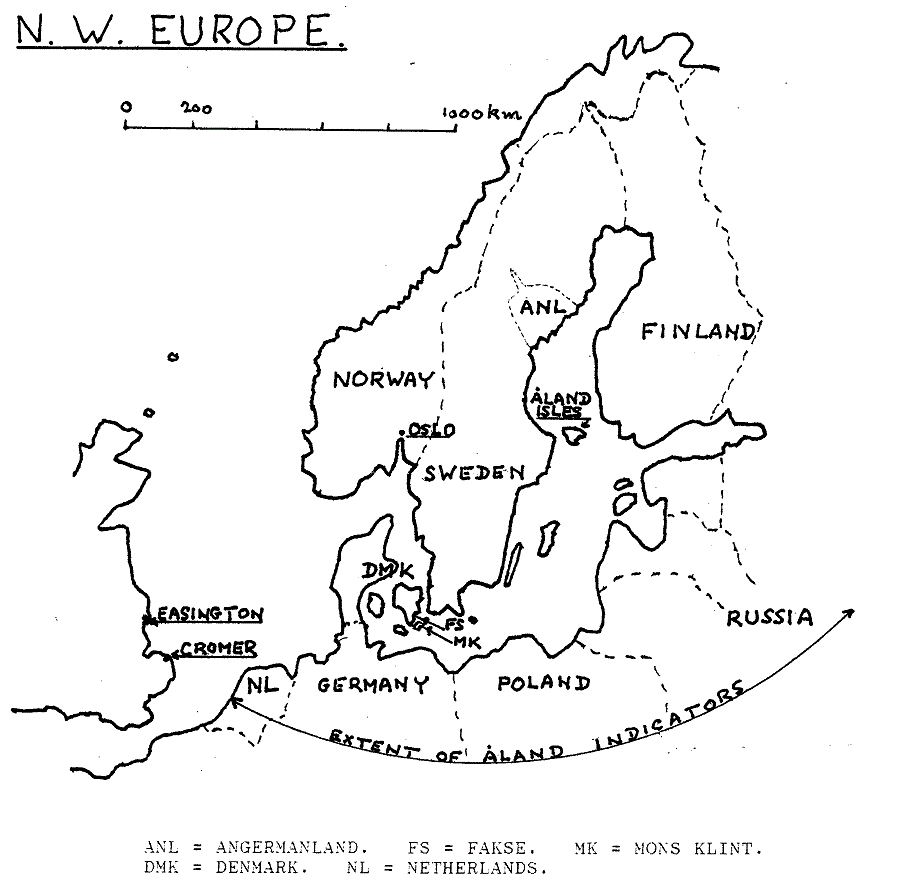

Humberside Geologist no. 10
For some years I have been collecting erratic rocks from the beaches of North Norfolk near Cromer. I have put some of the distinct ones into look-alike categories and attempted to discover their sources of origin.
One group whose provenance is more distinct than any other in my collection is the rapakivi rocks of the Åland Islands, Finland, some 1400 kilometres from Cromer - see attached map. Rapakivi texture is a term derived from the appearance or certain granites from Finland and refers to round potassic feldspar crystals mantled by sodic feldspar. The Åland rapakivi granite is typically medium red to light red-brown with infrequent 10-20mm round (sometimes distorted) mantled feldspars. The rock is speckled with dark mafic minerals and grey quartz grains. Sometimes the quartz grains are large (5-10mm), round and mantled and sometimes the matrix is finer and the rock is described as a quartz porphyry. A further variant is the Haga granite which has a yellow-red appearance with light grey quartz grains arranged in circles around the feldspars and with fewer dark inclusions. These descriptions are poor substitutes for actual specimens and for identification purposes, I believe one should have authenticated samples and do side by side comparisons.
I have found 4 definitive examples of this rock in roughly 400 hours of beach-combing, an average of 100 hours to find one stone. This order of magnitude estimate is given to show how rare these stones appear to be. For comparison, I have collected some 200 rhomb porphyries (rocks from the Oslo region of Norway) in the same period, a rate of one stone in 2 hours. On the North Humberside coast near Easington, one can pick up there rhomb porphyries at about 10 per hour.
The specimens were sent to Professor J.J.Donner in Finland who passed them to Dr L. Bergman of Åbo Akedemi University. The latter wrote the following: "All your samples, except sample 2, seem to be from the Åland rapakivi massif in SW Finland. Samples 3 and 82: quartz-porphyry like rapakivi: note the hornblende-chlorite mantled quartz megacrysts, typical of this rock type. Sample 81: A variety of 3 and 82. Sample 86: even-grained rapakivi very likely from the Haga stock in central Åland." Mr Huisman of the Natuur Museum in Groningen earlier identified sample 86 as a Haga granite.
Previous reports of Åland indicators in England. (Erratics whose source is established are called indicators). From 1897 to 1902. British Association Reports(1) list 4 finds on the North Humberside coast by Messers Stather, Crofts and Sheppard, names which will be familiar to members of the Hull Geological Society. The first was identified by Dr Munthe as 'a granite from Ångermanland or Åland' Then W.C.Brögger said they resembled the (rapakivi) rocks of Ragunda in Ångermanland and they were thereafter called Ångermanland granites. In 1908, V.Milthers (2) considered this determination to be doubtful, saying Ångermanland indicators are extremely rare on the Continent whereas these from Åland are common in Holland and their occurrence in England therefore seems possible; this opinion is supported by the summary of stone counts given by Overweel (3) where numbers of the two rock types are roughly 15 to 1. In 1926 Phemister (4) cites the B.A. Reports and also a paper by Trechman(5) but here the only relevant remark is 'Baltic granites of the rapakivi type are, I believe, commonly found in the Holderness drifts.' In 1957, Charlesworth (6) states that 'the westward displacement of the Norwegian ice by the baltic glacier is witnessed by the Åland granites in east Norfolk'. This is the clearest statement to date, but the evidence behind it is not apparent.
Extent of Åland indicators. In continental Europe, stone counts of Scandinavian indicators have been used for many years to assist studies of the directions of ice movement. The southern limit and lateral extent of the Åland indicators taken from Overweel(3) is marked on the map. Overweel gives a summary of 60 stone counts in the Netherlands and shows that the Åland + Finland indicators average a surprising 40% of the total compared with only 1% for the Oslo indicators. In Denmark, most of the Åland rocks occur in the south; on the SW coast near Fakse and on Möns Klint they can readily be picked up on the seashore.
Conclusion. The number of Åland indicators reported to have been found in England is very small. All the specific finds have been on East Coast beaches where stone beds are large concentrates of hundreds of years of boulder clay cliff wastage. It is unlikely that all the Oslo erratics were brought here as ballast in sailing ships because some of them have been found inland in deposits at 250 metres OD and others weigh 2 tonnes or more. It is possible that the ballast theory does apply to the Åland rocks, all of which are small and have been found at sea level. However the large number found in glacial deposits in the Netherlands makes transport by ice sheet, perhaps assisted by ice rafting, at least possible in our case. Further finds may tell us more.

References
1. British Association for the Advancement of Science Reports for 1897 (page 349), 1898 (page 552), 1899 (page 400), 1902 (page 256).
2. V. Milthers (1909). Scandinavian Indicator Boulders in the Quternary Deposits. Danmarks Geolog. Undersog.2,23 page 109.
3. C.J.Overweel (1977). Fennoscandinavian Indicators. Scripta Geol.43,Leiden Geological Museum.
4. J.Phemister (1926). Distribution of Scandinavian Boulders in Britain, Geol. Mag. 63,page 433
5. C.T.Trechman (1914). Scandinavian Drift of the Durham Coast, Q.J.G.S.71, page 66.
6. J.K.Charlesworth (1957). The Quaternary Era. E.Arnold & Sons. Page 709.
copyright Hull Geological Society 1992 and 2020